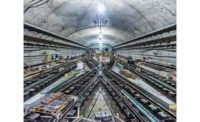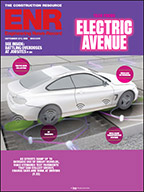As mining proceeds, rock bolts and steel ribs are installed to provide temporary tunnel support as required. At intervals the tunneling team probes ahead to insure they don�t mine into bad ground or water conditions.
�Average penetration is expected to be 50 to 60-feet a day,� Scagnelli says. The pace takes into consideration the installation of rock supports, maintenance, changing cutter discs, grouting as required and probing.
The rotating cutterhead equipped with buckets that scoop up the debris and deposit it on a conveyor belt inside the TBM. The conveyor system transfers the material to the rear of the machine for removal.
Excavated material from the TBM is transported by another conveyor system to the launch box. Instead of using a conventional crane hoisting system, a vertical conveyor with buckets will lift the excavated materials to the surface and deposit it in waiting trucks. �It is quieter and more reliable and we believe it will be accepted by the community,� Scagnelli explains.
To meet the schedule, tunnel mining will occur 24 hours a day. Above ground operations must cease after 10pm to minimize noise.
�To work 24 hours we came up with a system that uses the full length of the launch box to store the excavation underground using a series of stacking conveyors,� Scagnelli says. The material is transported to the surface during the day, starting at 7am in the morning.
Mining of the 5,006-ft. long west tunnel started in late May and is expected to take five-months. When completed the TBM will be pulled back to the launch box and slid over to drive the 5,800-ft. east tunnel, which will take seven months.
The concrete liner for the west tunnel will be constructed during mining of the east tunnel. The length of both tunnels will be lined except where the tunnels pass through future stations. That work, along with excavation of the stations, will be bid under further contracts.
|
Key Players Owner: MTA Capital Construction, New York Designer: A joint venture between AECOM, Los Angeles, and ARUP, New York. Contractor: S3 Tunnel Constructors, a joint venture of Skanska USA Civil of Whitestone, N.Y., Schiavone Construction of Secaucus, N.J., and J.F. Shea Constructors of Walnut, Calif. Construction Manager: PB Americas, Inc., New York Slurry Walls: Case Foundation, Roselle, Ill. |
The poured-in-place liner will use concrete reinforced with steel and polypropylene fibers for fire protection. �During a fire the polypropylene fibers melt, creating voids,� Caiden explains. �The voids allow space for the water held within the concrete to expand into as it becomes vapor. This minimizes explosive spalling that would otherwise occur and reduces fire damage.�
Additional work under this contract includes construction of two 30-ft diameter shafts at 72nd Street and 69th Street and a pumping station at 78th Street. The shafts will be used by a future contract to construct the 72nd Street Station.
Follow-on Contracts
At the contract�s completion, the launch box will be turned over to an E.E. Cruz�Tully Construction joint venture to do the structural work for the 96th Street station. Cruz-Tulley will also extend the station to connect with a tunnel segment stretching from 99th to 105th Streets built in the 1970�s. The segment will be used for train storage and maintenance.
Additional contracts will be awarded for fit-out of the 96th Street Station; excavation and construction of the 86th and 72nd Street Stations; rehabilitation work on the existing 63rd Street-Lexington Avenue Station; and installation of track, power, signal, and communications systems.
div id="articleExtras"





Post a comment to this article
Report Abusive Comment